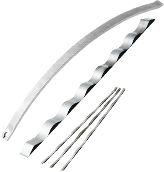Spring Design
Design information for engineers, such as spring calculation formulas,
which are the basis of spring design, can be found here.
- Tokai Spring HOME
- Spring Design
- Extension Springs: Things To Note In Spring Design
Extension
Springs
Characteristics and Shapes of Extension Springs
After compression springs, extension springs are widely used, and they are characterized by the hooks at both ends. Further, in the case of manufacturing by tight winding in cold forming process, the initial tension of the extension springs is the most different from that of the compression springs.
There are various hook shapes depending on the application, and stress concentration points are different in each, so caution is required when setting the stress.
The hook shapes described in JIS B 2704 are as follows.
1.Machine Half Hooks
The coil is half-bent to form a hook, which is easy to process.

2.Machine Hooks
They are hooks made by raising one turn of the coil part, and are easy to process.

3.Cross-over Hooks
They are hooks made by twisting one turn of the coil and are often used for cold forming springs with a small material diameter.

4.Side Hooks
One coil of the spring is raised to the side to form a hook. Since an extreme eccentric load is applied, the local maximum stress may be about twice that of the coil, so it is necessary to pay attention to that.

5.Extended Hooks
The end part is processed into a square shape and is used when it is attached to a flat plate, and the length of the hook is determined as required.

6.U-shaped Hooks
The end is U-shaped, and the hook length is set as required.

7.V-shaped Hooks
The end is V-shaped, and the hook length is set as required.

8.Tapered Machine Hooks
Insert the metal fitting and coil about 3 turns on one end when coiling, and use the inserted metal fitting as a hook. Although the length of the spring becomes long, it is not necessary to consider the stress concentration on the hook, so it is a recommended method.

9.Screwed-in Hooks
Screw in another metal fitting to the spring as a hook. Although the length of the spring is longer than when using tapered machine hook, it is not necessary to consider stress concentration at the hook part, so this is also a recommended method.

10.Diagonal Machine Hooks
One coil is raised at an angle at the end of the coil making a new hook shape. It is also easy to shape.

Initial Tension
When the extension spring is coiled solidly by cold-formed coiling, the coil is coiled at a pitch smaller than the calculated solid pitch, and so the wire section is, to some extent, formed in a twisted shape. As a result, the elastic deformation in the axial direction is prevented by the mutual bonding of the wires, and a force acts to keep the coils in close contact with each other even when there is no load. This is the so-called initial tension. Accordingly, the load-deflection diagram is as shown in Figure 7.
The initial tension for a normal steel spring is in the scope indicated by the diagonal lines in Figure 9.
However, Figure 8 shows the shear stress instead of the initial tension. The initial tension is calculated by the following formula.

To calculate the general shear stress due to the initial tension, you can use the following empirical formula.

Generally, extension springs actively leverage the initial tension. Thus, if the low-temperature annealing post molding is carried out at a excessively high a temperature for a long time, the initial tension will decrease. Consequently, this low-temperature annealing must be done properly. Also, in the event the surface treatment is performed, the spring may be heated, and so similar considerations must be given.
The initial tension reduction of materials other than steel wire and low-temperature annealing is as follows. For stainless steel wire, it is reduced by 15%. For phosphor bronze wire, brass wire, and nickel silver wire, it is reduced by 50%. When low-temperature annealing is carried out post molding, the values for piano wire, rigid steel wire, etc. shall be reduced by 20–35% and those for stainless steel wire shall be reduced by 15–25%.



















